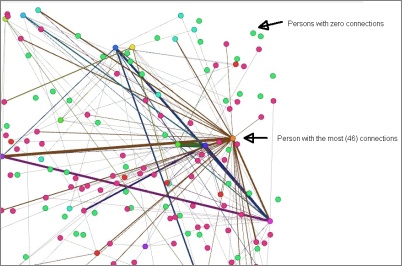Upon the recommendation of a friend, this week, I read the book „The Circle“ from Dave Eggers, which had quite an effect on me – especially when taking a MOOC with the topic SNA at the same time… Therefore and because I had a heavy workload in my job, I postponed engaging with DALMOOC from the evenings to this weekend. I was really interested in this week’s hangouts and watched the recordings (http://www.youtube.com/watch?v=GUUaP39VpLI and http://www.youtube.com/watch?v=ziM0EvN9n0o) which were fascinating and brought to my attention the level of „that we as participants are object of study as well“. Personally, I find it a little bit scary that my social media and learning activity is under such scrutiny. Certainly I knew before the course that it would be the case – learning analytics naturally means monitoring and drawing conclusions – but it’s different when it’s for real. However, at this moment, I don’t know yet enough of what is possible via Learning Analytics and what is commonly in use. Maybe it’s inevitable and in five years or so it will be quite normal, but I think we as educators really have to think about which tools we are using and how we do that – We have to be very, very careful with our learner data at our universities.
SNA Case Studies
This week, we got an insight in some SNA case studies and the educational constructs which were used (e.g. learning design, sense of community, creative potential, social presence, academic performance, distributed MOOC pedagogy). Thankfully the full text was available and I’ll keep these examples in mind for further reading later on. SNA can help to detect patterns of interactions in online learning environments and instructors could start intervening depending on the intended learning design (e.g. from an instructor-centered network to an „equal distribution of student distributions“). Sense of community means to which extent learners feel that they belong to a community and on the other hand benefit from participating in the community (getting information, getting feedback, also relevant for student retention in universities). The aspects creative potential („network brokers are associated with achievement and creativity“), social presence („teaching presence facilitates the development of network centrality by guiding students to establish social presence“) and academic performance („those students who were central in cross-class networks had best academic performance“) were also covered in studies, but I just watched the intro-videos.
In order to learn more about cMOOCs (where social media is an integral part), this article about Twitter use in CCK11 (socio-technical approach: nodes are persons and hashtags) is very interesting: http://www.sfu.ca/~dgasevic/papers_shared/bjet2014_cmoocs.pdf
Unfortunately I don’t have the time for further experiments with Gephi (which I would really have liked to do because I value that we are doing something concrete with tools) and week 5 with different topics is near.

